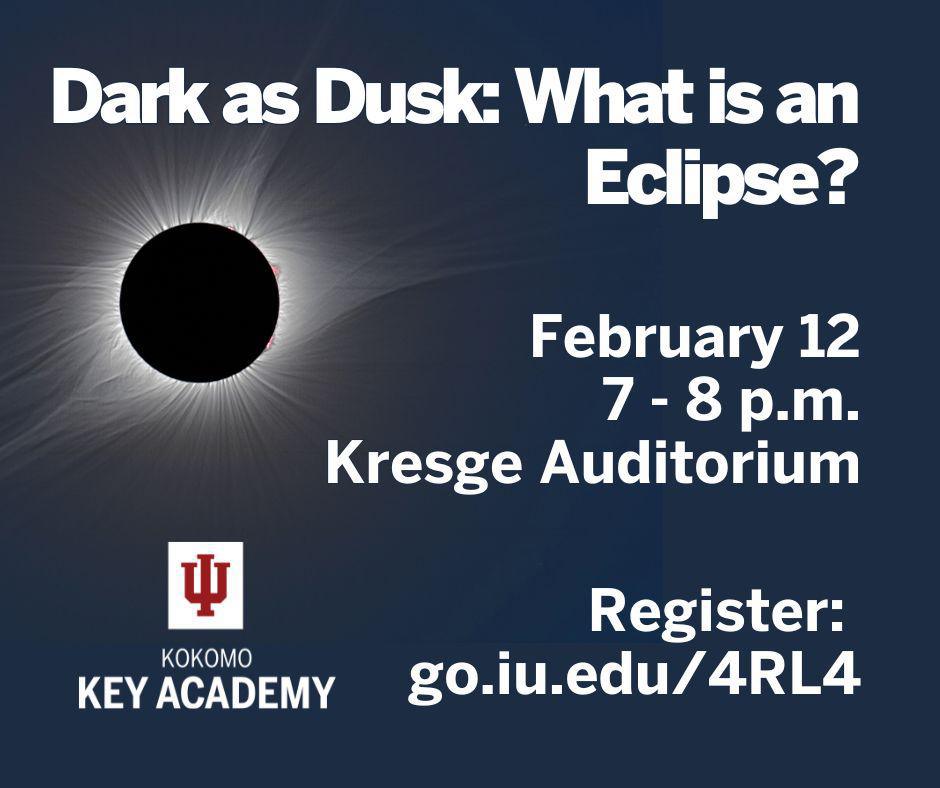This article is brought to you by Solidarity Community Federal Credit Union. Whether you are shopping for your first home, vacation home or forever home, our mortgage calculators can help you with estimates.
Solidarity Mortgage NMLS #804855
Click here bit.ly/47RP2n3 to check it out.
#mortgagecalculator #solidaritycommunityfederalcreditunion
For less than one minute, people in southern Kokomo will see something that no living creature today ever has: a total eclipse of the sun darkening the City of Firsts. On April 8, the city will be in the path of totality – a 100-mile wide band of shadow caused by the moon crossing in front of the sun.
Such an occurrence last took place over Kokomo in 1806. It won’t happen again until 2334. It is literally a once-in-a-lifetime event, and Indiana University Kokomo is gearing up to help residents enjoy and appreciate the eclipse with a series of events centered around the IUK Observatory.
IU Professor of Physics Dr. Patrick Motl will kick off the countdown to totality on Mon., Feb. 12, from 7-8 p.m. in Kresge Auditorium with a talk about the eclipse and what people can expect. Register for this event by visiting www.go.iu.edu/4RL4 .
“Something like one percent of people have ever experienced totality, so a lot of people don't know what it looks like,” said Motl. “You’ll want to know what you're going to see and what things are going to be like for 40 seconds or so.
“So, we’ll give you a sense of what eclipses are and what you're going to experience. We’ll talk about other dates involving an eclipse and the multicultural views of the eclipse. We'll have speakers to talk about eclipses from different traditions. Of course, we’ll talk about some of the things that will be going on for the eclipse, like if you want to be involved in a citizen science project, or if you want to do photography or videography of the eclipse.”
While Kokomo is in the path of totality, it sits at the edge of the event. People living in the northern half of the city will just miss totality, while those in the south will see it for less than a minute. The length of totality increases farther south. By comparison, Bloomington will experience totality for approximately four minutes.
The eclipse will begin at approximately 3:08 p.m. The timing isn’t exactly convenient for working people and schoolchildren. Some schools in the path of totality are releasing early or cancelling school altogether to ensure their kids have a chance to see the eclipse. If the Howard County Schools amend their schedules, the Kokomo Lantern will share that information.
The IU Kokomo Observatory will hold an open house during the eclipse on April 8. From 1:30-4:30 p.m., visitors can learn about the eclipse, view the observatory’s telescopes, and then watch the totality.
For those who hate crowds, Kokomo’s position will spare them the worst of the event. Indianapolis and Little Rock, Ark., for instance, are expected to receive remarkable influxes of eclipse viewers due to their central location in the eclipse’s path.
“Basically, the assumption is the further away you are, the less likely you are to drive to the totality,” said Motl. “Still, the easy assumption is Indiana will get somewhere between 100,000 to a million people coming for the event.
“The last time totality crossed the continental U.S., there was a city in South Carolina in its path. They had their population increase by about a factor of five for the day.”
Be warned. Mother Nature may put a damper on the entire event for Kokomo. According to Motl, approximately 70 percent of April 8ths in Kokomo have been overcast, historically. If clouds spoil the party, IU Kokomo will be livestreaming the event from other locations so at least a video can be seen.
Otherwise, viewers will have to wait a couple years before totality takes place again. A total eclipse will pass over northern Spain, western Iceland, and eastern Greenland in 2026. If they want to stay in the U.S. to see it, that will mean a trip to North Dakota or Montana in 2044.
For those who choose to stay home to watch the eclipse, Motl has some important advice.
“You should never look at the sun directly, whether it is during an eclipse or a sunny day,” said Motl. “Don't go out and stare at the sun. It will hurt your eyes. Even during an eclipse, the only time that is safe to look at the sun directly without eye protection is during the brief period of totality.
“You have to have eye protection, or you can look at an indirect image of the sun, like with a pinhole camera or reflection from another surface. And you have to make sure you have real eclipse glasses if you’re using those.
“During the 2017 Eclipse, there were counterfeit glasses that got dumped on Amazon. Don’t trust that. The American Astronomical Society keeps a list of vendors for eclipse glasses and viewers that have been tested.”
IU Kokomo will offer eclipse glasses as part of their eclipse events. On Feb. 26, IU Kokomo will welcome “The Bad Astronomer” Dr. Phil Plait for a dinner and lecture.
Plait worked on the Hubble Space Telescope as a NASA contractor at the Goddard Space Flight Center But his claim to fame is his public outreach and education with the Bad Astronomy website and blog, debunking bad science and popular misconceptions.
The Bad Astronomer, as he has become known thanks to his presence online, has written two books, produced the “Crash Course Astronomy” web series, and a series on the Discovery Channel. Plait gives talks about science and pseudoscience across the U.S. and internationally.
The table is filling quickly, but astronomy fans can join Plait for dinner prior to his presentation on Mon., Feb. 26. Dinner is $50 per person, and registration is required by visiting www.go.iu.edu/4Rtv . Dinner takes place from 5:30-6:45 P.M.
From 7-8 p.m., The Bad Astronomer will give his presentation on the eclipse in Havens Auditorium. Attendance is free to this presentation, but registration is required by visiting www.iu.edu/4RMj.
Motl holds an open house at the IU Kokomo Observatory every month during the school year. Each session focuses on a different topic involving astronomy. On Sun., Feb. 11, at 7 p.m., he will give a presentation about dark energy, including recent results from the Dark Energy Survey project, an international collaborative effort to map hundreds of millions of galaxies, detect thousands of supernovae, and find patterns of cosmic structure that will reveal the nature of the mysterious dark energy that is accelerating the expansion of our universe.
After the presentation, stargazers may be able to see Jupiter and highlights from the winter triangle like the Orion Nebula through the Observatory’s telescopes, a six-inch Takahashi refracting telescope and a 16-inch Meade reflecting telescope mounted together. The Takahashi provides exceptionally sharp images of planets, while the Meade allows viewers to see fainter objects in the sky, due to its larger light-collecting area.
Observation will continue through 9 p.m., weather permitting. The Observatory is at 2660 S. Washington Street. Free parking is available on campus.




